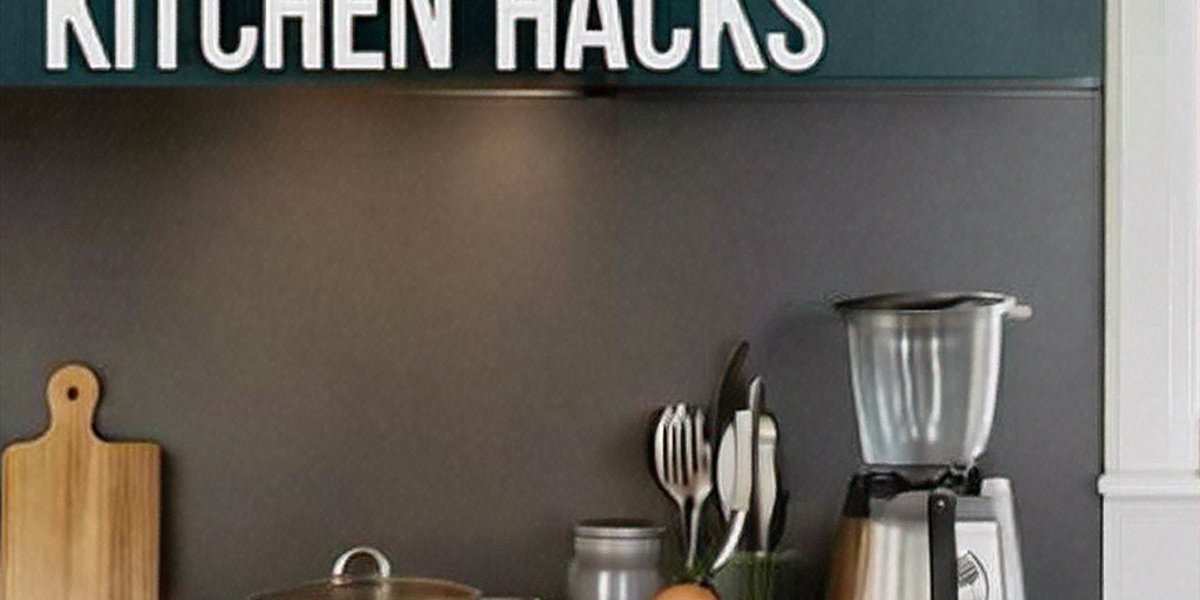30-Second Kitchen Hacks
Small optimizations compound. These micro-habits reduce friction so cooking feels faster and cleaner without sacrificing flavor.
Setup That Saves Time
The Grab Row
Keep a "grab row" next to your stove: salt, pepper, olive oil, garlic, vinegar, and your most-used spices. When ingredients are within arm's reach, you'll use them more often. This simple change can reduce cooking time by 10-15% just by eliminating the back-and-forth to the pantry.
Pan Preheating Strategy
Put a sheet pan on the top rack while your oven preheats. This builds better browning for vegetables and proteins. The pan absorbs heat gradually, creating an even cooking surface that prevents sticking and promotes caramelization. For stovetop cooking, always preheat your pan before adding oil - this prevents food from sticking and ensures even cooking.
Trash Bowl System
Keep a small bowl on your counter while cooking. All scraps go directly into it, keeping your cutting board clear and your knife moving. This simple habit saves 2-3 minutes per meal and makes cleanup much easier.
Flavor, Faster
Salt Timing Mastery
Salt early, not just at the end. Season meat 30-60 minutes before cooking to allow the salt to penetrate and enhance natural flavors. For vegetables, salt immediately after cutting to draw out moisture and concentrate flavors. This technique can transform bland ingredients into restaurant-quality dishes.
Acid as a Force Multiplier
A teaspoon of vinegar or lemon juice brightens dull dishes instantly. Add acid at the end of cooking to preserve its bright, fresh character. Different acids work better with different foods: white wine vinegar with fish, apple cider vinegar with pork, lemon with chicken, and rice vinegar with Asian dishes.
Spice Toasting Technique
Toast spices in a dry pan for 20-30 seconds until fragrant before adding fat. Heat unlocks aromatic compounds and creates deeper, more complex flavors. This is especially important for whole spices like cumin, coriander, and mustard seeds.
Clean-As-You-Go Blueprint
Hot Water Strategy
Fill your sink with hot, soapy water before you start cooking. Dirty tools can soak while you continue cooking, making cleanup much faster. This simple habit can reduce post-meal cleanup time by 50%.
Lining Strategy
Line baking trays with parchment paper or foil. When you're done, simply slide off the mess - your tray stays clean and ready for the next use. This is especially useful for roasting vegetables, baking cookies, or making sheet pan dinners.
Transition Wiping
Wipe your counter with a folded towel after each major step. This resets your surface and your mental state, making the cooking process feel more organized and less overwhelming.
Knife Speed Without Risk
Tip Anchoring Method
Anchor the tip of your knife on the cutting board and rock the blade back and forth. This technique is faster and safer than lifting the entire knife for each cut. It's especially effective for mincing herbs, garlic, and onions.
Stack-and-Slice Technique
For herbs and leafy greens, stack them tightly like a cigar and slice across the stack. This creates uniform ribbons in one pass, saving time and creating more professional-looking results.
Push Cut Mastery
Use push cuts instead of pull hacks. Push the knife forward and down in one smooth motion. This technique is more stable, creates cleaner cuts, and reduces the risk of slipping.
Quick Wins You'll Use Tonight
Garlic Peeling Hack
Microwave garlic cloves for 8 seconds to loosen the skin, making them peel instantly. This works for both individual cloves and whole heads of garlic.
Bench Scraper Transfer
Use a bench scraper to transfer chopped items from your cutting board to your pan. This protects your knife edge and is much more efficient than using your hands or the knife itself.
Flavored Fat Finishing
Finish dishes with a flavored fat: chili oil, herb butter, or sesame oil. This adds maximum flavor with minimal effort and can transform simple dishes into something special.
Advanced Time-Saving Techniques
Batch Prep Strategy
Dedicate one day per week to batch prep. Chop vegetables, portion proteins, and prepare sauces in advance. This can reduce weekday cooking time by 70% and makes healthy eating much more achievable.
What to prep:
- Mirepoix (onions, carrots, celery) for soups and stews
- Garlic and ginger paste for Asian dishes
- Herb butters and compound butters
- Roasted vegetables for quick sides
- Cooked grains like quinoa, rice, and farro
Storage tips:
- Use clear containers for easy identification
- Label with contents and date
- Store in the order you'll use them
- Freeze items that won't be used within 3 days
Freezer Organization
Organize your freezer with clear containers and labels. Group similar items together and keep an inventory list. This prevents food waste and makes meal planning much easier.
Freezer organization system:
- Top shelf: Ready-to-eat items and leftovers
- Middle shelf: Proteins and main dishes
- Bottom shelf: Vegetables and fruits
- Door: Small items like herbs, butter, and sauces
Freezer inventory template:
- Item name and quantity
- Date frozen
- Best by date
- Suggested use
Equipment Optimization
Invest in multi-purpose tools that do multiple jobs well. A good food processor, immersion blender, and cast iron pan can replace dozens of single-purpose gadgets.
Essential multi-purpose tools:
- Food processor: Chopping, pureeing, mixing, kneading
- Immersion blender: Soups, sauces, smoothies, dressings
- Cast iron pan: Searing, baking, frying, roasting
- Dutch oven: Braising, stewing, baking, frying
- Mandoline: Slicing, julienning, grating
Maintenance Habits
Weekly Sharpening
Sharpen your knives weekly to maintain peak performance. A sharp knife is safer and more efficient than a dull one.
Sharpening schedule:
- Monday: Chef's knife and paring knife
- Wednesday: Serrated knife and utility knife
- Friday: Specialty knives (boning, fillet, etc.)
Sharpening techniques:
- Use a honing steel for daily maintenance
- Use a whetstone for weekly sharpening
- Professional sharpening every 6 months
- Test sharpness with paper or tomato skin
Monthly Deep Clean
Clean your oven, refrigerator, and other major appliances monthly. This prevents buildup and ensures optimal performance.
Monthly cleaning checklist:
- Oven: Remove racks, clean interior, replace racks
- Refrigerator: Remove shelves, clean interior, check seals
- Dishwasher: Clean filter, run empty cycle with vinegar
- Microwave: Clean interior, check turntable
- Coffee maker: Descale and clean carafe
Seasonal Organization
Reorganize your kitchen seasonally to match your current cooking habits. Move frequently used items to the front and store seasonal items in the back.
Spring/Summer organization:
- Move grilling tools to front
- Store heavy stew pots in back
- Organize fresh herb growing supplies
- Prepare for outdoor cooking season
Fall/Winter organization:
- Move slow cooker to front
- Store grilling tools in back
- Organize holiday baking supplies
- Prepare for indoor cooking season
Troubleshooting Common Kitchen Problems
When Food Sticks to Pans
Problem: Food sticking despite proper preheating. Solution: Ensure pan is fully preheated before adding oil, then add oil and let it heat until shimmering before adding food.
Problem: Food sticking to non-stick pans. Solution: Avoid high heat, use wooden or silicone utensils, and never use metal utensils on non-stick surfaces.
When Knives Feel Dull
Problem: Knife won't cut through food easily. Solution: Use honing steel daily, sharpen weekly, and avoid cutting on hard surfaces like glass or stone.
Problem: Knife edge feels rough. Solution: Check for nicks or damage, use proper cutting board, and consider professional sharpening.
When Timing Goes Wrong
Problem: Some items finish cooking before others. Solution: Use the "lowest common denominator" approach - start with items that take longest, add others based on cooking time.
Problem: Food is cold when everything else is ready. Solution: Use warming drawer, keep oven on low, or time final cooking steps to finish together.
Specialized Kitchen Hacks
Baking Efficiency
Room temperature ingredients: Take eggs, butter, and dairy out 30 minutes before baking for better mixing and consistent results.
Pre-measure dry ingredients: Measure and combine all dry ingredients the night before to save morning prep time.
Use kitchen scale: Weighing ingredients is faster and more accurate than measuring cups, especially for baking.
Grilling Mastery
Preheat properly: Allow 15-20 minutes for charcoal, 10-15 minutes for gas grills to reach optimal temperature.
Two-zone cooking: Create hot and cool zones for searing and finishing without burning.
Oil the grate: Use a paper towel dipped in oil to prevent sticking, not cooking spray which can cause flare-ups.
Asian Cooking Shortcuts
Garlic-ginger paste: Make in bulk and freeze in ice cube trays for instant flavor addition.
Pre-cut vegetables: Use food processor to julienne carrots, slice onions, and mince garlic in batches.
Sauce bases: Prepare common sauce combinations (soy-garlic-ginger, sweet-sour, etc.) and store in refrigerator.
Kitchen Safety Hacks
Fire Prevention
Oil temperature monitoring: Use a thermometer for deep frying, never leave hot oil unattended.
Grease fire response: Never use water on grease fires, use baking soda or a fire extinguisher.
Smoke alarm placement: Install smoke alarm in kitchen but not too close to cooking area to avoid false alarms.
Knife Safety
Proper grip: Use pinch grip (thumb and forefinger on blade, other fingers on handle) for better control.
Cutting board stability: Place damp towel under cutting board to prevent slipping.
Knife storage: Use knife block, magnetic strip, or blade guards to protect edges and prevent accidents.
Food Safety
Temperature monitoring: Use instant-read thermometer for meats, keep refrigerator at 40°F or below.
Cross-contamination prevention: Use separate cutting boards for raw meat and vegetables, wash hands frequently.
Leftover management: Cool food quickly, refrigerate within 2 hours, and use within 3-4 days.
Seasonal Kitchen Adaptations
Spring Kitchen
Fresh herb garden: Start small herb garden on windowsill or balcony for instant access to fresh flavors.
Light cooking methods: Focus on steaming, poaching, and quick sautés to highlight fresh spring vegetables.
Easter preparation: Organize baking supplies, prepare make-ahead dishes, and plan menu in advance.
Summer Kitchen
No-heat meals: Prepare salads, cold soups, and no-cook dishes to avoid heating up the kitchen.
Grilling prep station: Set up outdoor prep area with cutting board, utensils, and seasonings.
Preservation projects: Make jams, pickles, and frozen fruit for winter use.
Fall Kitchen
Comfort food prep: Organize slow cooker recipes, prepare hearty soups and stews in advance.
Apple and pumpkin season: Stock up on seasonal produce, prepare for holiday baking.
Thanksgiving planning: Create timeline, prepare make-ahead dishes, organize serving pieces.
Winter Kitchen
Hot beverage station: Organize tea, coffee, and hot chocolate supplies for comfort drinks.
Soup and stew rotation: Plan weekly soup menu, use slow cooker for easy hot meals.
Holiday baking: Organize cookie cutters, prepare dough in advance, plan gift-giving strategy.
Building Your Kitchen System
Start Small
Choose 3-5 hacks from this guide and implement them consistently for one week. Once they become habit, add more.
Track Your Progress
Keep a simple log of time saved and improvements made. This helps maintain motivation and identify what works best for you.
Share and Learn
Share successful hacks with friends and family, and be open to learning new techniques from others.
Adapt and Evolve
Your kitchen system should evolve with your cooking habits, family size, and lifestyle changes. Review and adjust quarterly.
The Psychology of Kitchen Efficiency
Why Small Changes Matter
Minor improvements compound over time. Saving 2-3 minutes per meal adds up to hours saved each month.
The Flow State
When your kitchen is organized and your tools are sharp, cooking becomes more enjoyable and less stressful.
Confidence Building
Each successful hack builds confidence and makes you more likely to try new techniques and recipes.
Family Involvement
An efficient kitchen encourages family participation in meal preparation, creating positive memories and teaching valuable skills.
Conclusion
Kitchen efficiency isn't about being perfect—it's about being consistent. The hacks in this guide work because they address the real obstacles that slow down home cooking: disorganization, dull tools, and inefficient processes.
Start with the basics: organize your space, sharpen your tools, and establish simple routines. As these become second nature, add more advanced techniques. Remember, the goal isn't to turn your kitchen into a professional kitchen—it's to make your kitchen work better for you.
The most successful home cooks aren't those with the most expensive equipment or the most elaborate systems. They're the ones who have identified what slows them down and systematically addressed those issues. They've created environments where cooking feels natural and enjoyable rather than like a chore.
Your kitchen should work with you, not against you. With these hacks, you'll spend less time on setup and cleanup and more time enjoying the creative process of cooking. You'll find yourself cooking more often, trying new recipes, and sharing meals with family and friends.
The journey to kitchen efficiency is ongoing, but the rewards are immediate. Start tonight with one or two of these hacks, and you'll see the difference immediately. Before you know it, you'll have developed your own system of kitchen shortcuts that makes cooking faster, easier, and more enjoyable than ever before.


